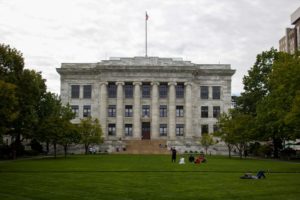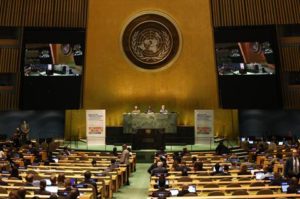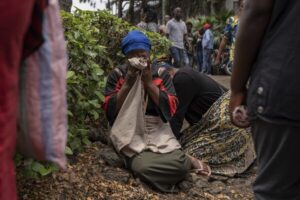The battle in Brazil over the territorial rights of Indigenous peoples has become one of the country’s most polarizing disputes
January 2, 2024 at 4:00 a.m. EST
JARAGUÁ INDIGENOUS TERRITORY, Brazil — Maysa Aquiles Benites, 16, lived in the largest city in the Western Hemisphere, but her life felt worlds apart from it. She had neither running water nor electricity. She spoke little Portuguese. While most pregnant Brazilians in São Paulo opt for a Caesarean birth at a hospital, she was planning something bolder.
She promised to give birth to her child on a forested bluff overlooking a highway, bereft of any modern comfort, because she believed it would help her people claim the land.
The Guarani are one of South America’s largest Indigenous groups but here live in Brazil’s smallest officially recognized Indigenous territory — four acres wedged between two highways and shadowed by a bus yard and construction equipment shop.
The Jaraguá territory was created by the Brazilian government for one family. But in recent years, the land has attracted hundreds of people, transforming this pebble-strewn patch of earth into a national battleground over one of Brazil’s most polarizing and protracted questions: How much land do Indigenous people warrant?
The matter has divided Brazil’s government. On one side is Brazilian President Luiz Inácio Lula da Silva, who signed a raft of decrees in 2023 increasing Indigenous lands in a country where they already account for 13 percent of the area. On the other side are Brazilian conservatives, who control the National Congress and last year passed legislation to restrict Indigenous lands.
As a constitutional struggle has mounted — first in a presidential veto of the legislation, then in Congress overriding that veto — political uncertainty has swept the country.
The debate’s outcome has vast implications for Brazil, but particularly the Guarani who’ve come to the Jaraguá territory. Unable to squeeze into the four acres, hundreds of Guarani have spilled into adjacent shantytowns. Many have spent years there waiting for the Brazilian government to approve a long-stalled plan that would vastly expand the territory to more than 1,300 acres of largely preserved forest just beyond the urban sprawl.
But for Benites and her family, the waiting was over. If they were ever to acquire the land — and pressure officials into making it official — they believed they’d have to seize it.
“A retaking” is what they called it.
In March, Benites’s mother-in-law led the family into the forest. They came to a remote, peaceful clearing with an expansive view of the highway and favelas beyond. It was perfect. No one else around. A source of water nearby. They planted a black flag high up on the hill and proclaimed the land Guarani.
But to attract more Guarani settlers and expand the village, Benites’s family wanted to show that the land here could sustain human life — even that of a newborn.
Benites, who wed and became pregnant before adulthood in keeping with Guarani mores, was nervous about her plan. Her people traditionally birth children on Guarani land without modern medicine. But she knew the custom here, so close to some of Latin America’s best hospitals, was rarely followed. For months, she’d wondered what was best — for her people, for herself, for her baby.
Now the pains had begun. Inside her hut atop the hill, the girl called to the child’s father.
It’s happening, she said.
A new village in the forest
The story of Indigenous territories in Brazil is usually one of vast lands and sparse populations. The Javari Valley in Amazonas state is the size of Portugal but has a population of roughly 6,000 people. This past year, Lula decreed several new Indigenous territories, one nearly the size of Delaware for 249 people. Another, larger than Baltimore, for nine people.
“So much land, so few Indigenous” is a slogan of the Brazilian right.
That has not been the story of the Jaraguá Indigenous Territory. Its population has swelled in recent decades as Guarani traveled here from all over the country to access jobs and educational opportunities in São Paulo. The Justice Ministry in 2015 recognized the Guarani right to more than 1,300 acres, leaving only a presidential signature to make it official.
But no president signed. And as the years went by, Guarani repeatedly clashed with local businessmen and staged dramatic protests. In 2020, Guarani rushed a nearby construction site, dressed for combat, prompting calls to the police. Then in May, Guarani demonstrators blocked one of the city’s main highways and were dispersed only after police shot rubber bullets at them.
“We fear they’re going to take from us all of the gains we’ve had,” Indigenous leader Anthony Karai Poty said.
The fight’s urgency was what attracted Benites’s family. Following Guarani nomadic custom, the family had bounced from village to village before settling here in 2020, itching to protest what they viewed as social injustice.
In March, mother-in-law Neusa Quadro, 35, proposed a quieter, but more radical, protest than what had come before. She wanted to venture into the forest — deep inside the territory sought by the Guarani — and establish a new village to complicate any effort to thwart their claims to the land.
The first night was miserable, they recalled. Quadro said they slept on the ground, underneath sheets of plastic. But it was a start. Soon other families arrived. They set up rudimentary houses, built a centralized house of prayer, and planted fields of vegetables and beans.
The only thing missing was the birth of a child.
Birthing a child atop a hill, far from the hospital
Benites, a shy girl who dreads attention, was suddenly the focus of it. Villagers gathered that October day around the house of prayer, where Benites lay on a mattress on the dirt floor in a smoke-filled room. People sang songs and chanted a birth prayer. Some gave her wild herb tea.
Guarani believe hot hands will quicken births, so witnesses said people took turns rubbing their hands together, then passing them across her swollen belly. Husband Danilo Estevão de Quadro, 17, looked on nervously. His mother, Quadro, said she crouched near Benites to offer words of encouragement.
It was too much attention. Benites felt “exposed,” she said. This wasn’t what she’d wanted at all.
People said they began to worry. The baby wasn’t coming. Even if they wanted to get to the hospital, it wasn’t clear they could. Rains the night before had made the path practically impassable. Benites said she was scared. No one around her had been trained in childbirth.
Three hours of labor. Now four.
Quadro came to her side and whispered in her ear.
“Do you want to go to the hospital?” she recalled asking.
“Yes,” Benites said she responded without hesitation. “I want to go.”
A car was somehow steered to the top of the hill. Four men hefted Benites and placed her in the back seat. Quadro got in beside her. They recalled bumping along the dirt road toward the highway, heading toward Hospital Geral de Taipas, 20 minutes away.
Benites said she couldn’t think, couldn’t talk. Outside the window, the verdant green of their forest village gave way to the flat gray of the cityscape.
And then, after hours of waiting: It happened. The baby. He came out, just as the family’s car made it to the highway. They pulled over onto the roadside. As Brazilians sped by, an Indigenous teenager who barely spoke Portuguese gave birth to a son.
The family continued on to the hospital. Benites was exhausted, but relieved. Brayan, now wrapped in a blanket, was healthy. She was healthy.
She lamented that she hadn’t given birth in their new village. She hoped she hadn’t disappointed her family. But even if she’d failed in that intent, it wasn’t too late for the family to realize part of their goal.
In traditional births, Guarani bury the placenta just outside their home’s entrance. The act binds the child to the household and guarantees them a secure home.
So that evening, as Benites rested, her husband returned to the territory the Guarani were seeking. He went into the woods and climbed the hill. He said he dug a hole and placed the placenta inside it and covered it with earth — their earth, he hoped.
“My son,” he’d later say. “He has a place to live.”
Three days later, Benites left the hospital with Brayan. She went into their hut with her baby and there, atop a hill overlooking the highway, felt safe.
The photography in this story was funded in part by a Catchlight Global Fellowship and a National Geographic Society Explorer grant.




